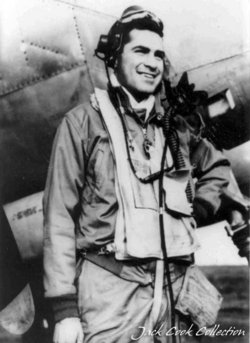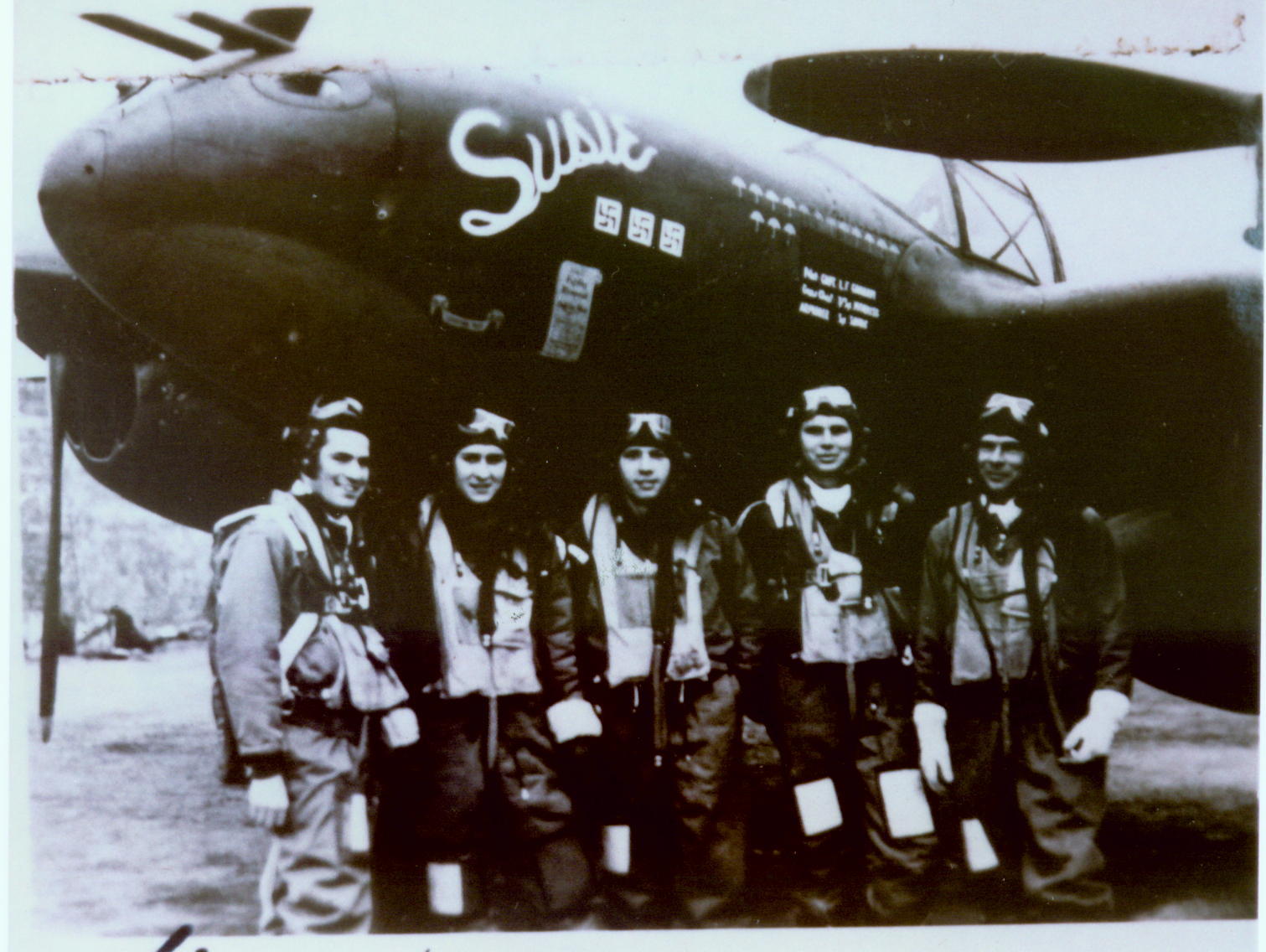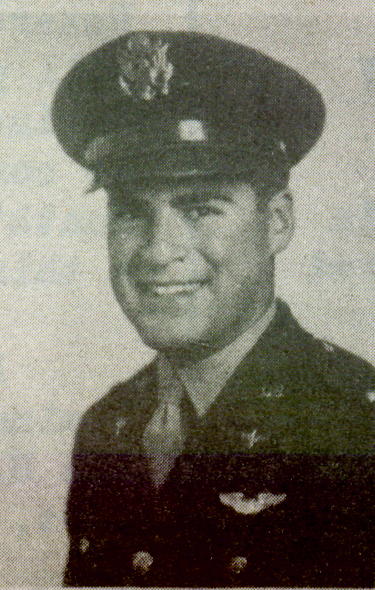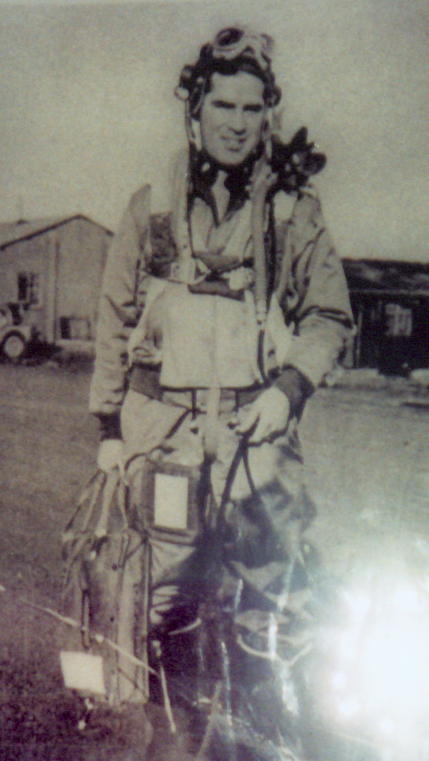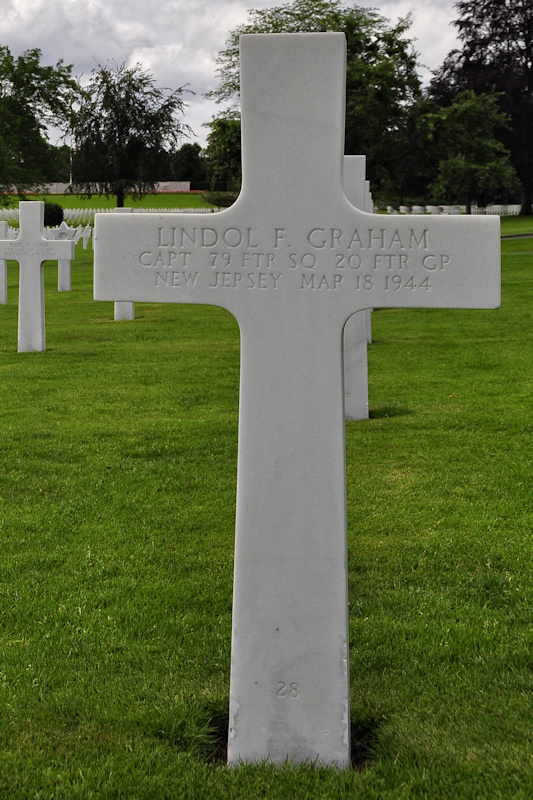Lindy was born November 15, 1918 and lived at 76 Crest Road with his parents, two brothers and one sister. He went to high school in Watertown, Mass. where he was in the band and orchestra, played tennis and basketball, was Treasurer of the class of '36, was on the class day committee and in the class play. He then went to Dartmouth where he got a degree in economics in 1941 and was a member of Phi Delta Theta. 11 days after Pearl Harbor he was called to service and reported to Maxwell Field in Alabama. After basic training in Greenville, Miss. he received advanced flight training at Selma, Ala. where he received his commission. At this time, he was engaged to Marjorie Smith, the sister of a Dartmouth classmate.
He arrived overseas August 31, 1943 as part of the 79th Fighter Squadron, 20th Fighter Group 8th Air Force based in Kings Cliffe, Northamptonshire, England where he was given a bicycle so he could tour the English countryside while waiting for war planes to arrive. "Lucky Lindy", 5' 8" and 147 lbs., was initially the Operations Officer but became a P-38J "Lightning" pilot Ace.
The P-38 was a twin-engine high-altitude interceptor, built by Lockheed. A long-range escort fighter, it was also used for dive bombing, level bombing, ground strafing and photo reconnaissance missions. It could out climb and out dive nearly every enemy fighter. The first fighter with two engines, the first fighter with tricycle landing gear and the first American fighter to shoot down a German aircraft after the US entered the war, its maximum speed was 414 mph with a range of 2,260 miles. It was powered by two 1,425 hp Allison V1710 engines and weighed 21,600 lbs. It was armed with a 20mm cannon and four machine guns.
His first three kills occurred on January 29, 1944 on an escort mission to Frankfurt for which he was awarded the Distinguished Flying Cross. The citation reads "The courage, aggressiveness and superior flying skill displayed by Captain Graham in destroying three enemy aircraft during one mission reflect highest credit upon himself and the armed forces of the United States".
Three weeks later on February 20 he knocked down two Me-110s in the Koblenz area to become the 79th Fighter Squadron's first ace. He had named his plane "Susie" for his fiancée. "Take today for instance. Susie got plenty worked up when two Messerschmitt 110s started acting crazy up there and thumbing their noses at us. Lt. Marion Bench and I were helping to protect some heavy bombers and those two Jerries circled up to within 300 yards of us before taking any sort of evasive action. They were really asking for it. Bench and I started blasting away and knocked out both engines of one of the Nazi ships in short order. But the prettiest sight was when the ship broke in two. It went down in flames, with its whole tail assembly shot off. Then we skidded over and gave the other guy the works. We kept shooting until we saw him go down in smoke".
In March 1944, as part of a new Allied tactic, 79th pilots swept target areas after the bombers had departed, earning the squadron its nickname "Loco Squadron". Lindy's last victory occurred on the day he was killed during just such a strafing mission near Ulm, Germany. At about 2:00 in the afternoon of March 18, he had descended from 20,000 feet to attack two M110s that had just taken off. He went after one plane and made repeated attacks until the enemy plane crashed. Flying low, he returned to strafe the plane when his propellers hit the ground. The plane pulled up and then crashed on its back and burned.
Lindy was also awarded the Air Medal with three Oak Leaf Clusters. He is buried at Plot F Row 7, Grave 28 in the Lorraine American Cemetery, St. Avold, France. At death he was 25 years old.
Lindy was born November 15, 1918 and lived at 76 Crest Road with his parents, two brothers and one sister. He went to high school in Watertown, Mass. where he was in the band and orchestra, played tennis and basketball, was Treasurer of the class of '36, was on the class day committee and in the class play. He then went to Dartmouth where he got a degree in economics in 1941 and was a member of Phi Delta Theta. 11 days after Pearl Harbor he was called to service and reported to Maxwell Field in Alabama. After basic training in Greenville, Miss. he received advanced flight training at Selma, Ala. where he received his commission. At this time, he was engaged to Marjorie Smith, the sister of a Dartmouth classmate.
He arrived overseas August 31, 1943 as part of the 79th Fighter Squadron, 20th Fighter Group 8th Air Force based in Kings Cliffe, Northamptonshire, England where he was given a bicycle so he could tour the English countryside while waiting for war planes to arrive. "Lucky Lindy", 5' 8" and 147 lbs., was initially the Operations Officer but became a P-38J "Lightning" pilot Ace.
The P-38 was a twin-engine high-altitude interceptor, built by Lockheed. A long-range escort fighter, it was also used for dive bombing, level bombing, ground strafing and photo reconnaissance missions. It could out climb and out dive nearly every enemy fighter. The first fighter with two engines, the first fighter with tricycle landing gear and the first American fighter to shoot down a German aircraft after the US entered the war, its maximum speed was 414 mph with a range of 2,260 miles. It was powered by two 1,425 hp Allison V1710 engines and weighed 21,600 lbs. It was armed with a 20mm cannon and four machine guns.
His first three kills occurred on January 29, 1944 on an escort mission to Frankfurt for which he was awarded the Distinguished Flying Cross. The citation reads "The courage, aggressiveness and superior flying skill displayed by Captain Graham in destroying three enemy aircraft during one mission reflect highest credit upon himself and the armed forces of the United States".
Three weeks later on February 20 he knocked down two Me-110s in the Koblenz area to become the 79th Fighter Squadron's first ace. He had named his plane "Susie" for his fiancée. "Take today for instance. Susie got plenty worked up when two Messerschmitt 110s started acting crazy up there and thumbing their noses at us. Lt. Marion Bench and I were helping to protect some heavy bombers and those two Jerries circled up to within 300 yards of us before taking any sort of evasive action. They were really asking for it. Bench and I started blasting away and knocked out both engines of one of the Nazi ships in short order. But the prettiest sight was when the ship broke in two. It went down in flames, with its whole tail assembly shot off. Then we skidded over and gave the other guy the works. We kept shooting until we saw him go down in smoke".
In March 1944, as part of a new Allied tactic, 79th pilots swept target areas after the bombers had departed, earning the squadron its nickname "Loco Squadron". Lindy's last victory occurred on the day he was killed during just such a strafing mission near Ulm, Germany. At about 2:00 in the afternoon of March 18, he had descended from 20,000 feet to attack two M110s that had just taken off. He went after one plane and made repeated attacks until the enemy plane crashed. Flying low, he returned to strafe the plane when his propellers hit the ground. The plane pulled up and then crashed on its back and burned.
Lindy was also awarded the Air Medal with three Oak Leaf Clusters. He is buried at Plot F Row 7, Grave 28 in the Lorraine American Cemetery, St. Avold, France. At death he was 25 years old.
Gravesite Details
Entered the service from New Jersey.
Family Members
Sponsored by Ancestry
Advertisement
Explore more
Sponsored by Ancestry
Advertisement
